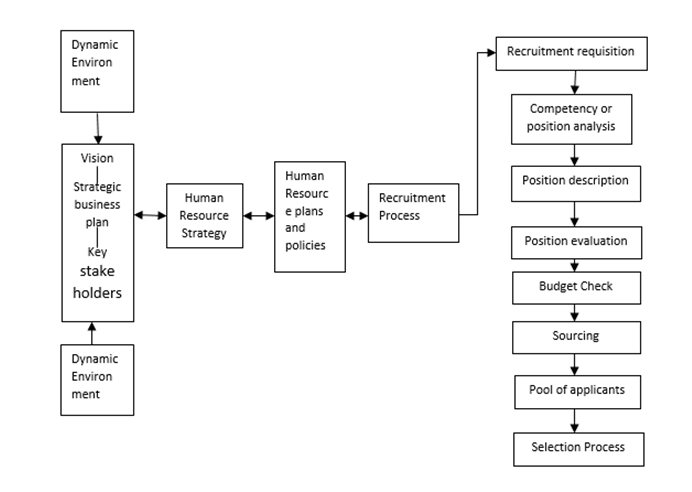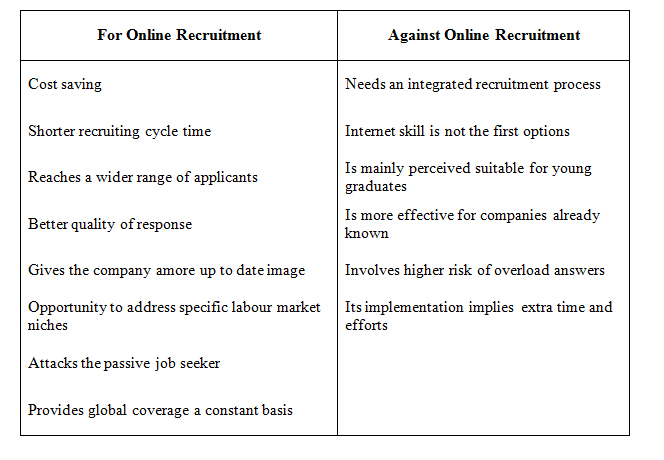Recruitment and Selection (Human Resource Management)
Human Resource Management constantly contributes to improve productivity and financial status of organization. There are many functions of human resource management. Recruitment and selection is seen as major function.
One of the significant roles of HRM is to select suitable staff and decide to hire right professionals or employees to fill recruitment needs, and provide training the best employees and, make certain that these selected candidates can give better performance, deal with performance issues and follow the rules to diverse system. Recruitment is of the fundamental job of Human Resource management. Fundamentally, recruitment is the process of attracting, assessing, and hiring employees for companies. Once HRM requirements are understood, the next step of HRM is to employ workers. Recruiting and staffing is a complicated activity in competitive business surroundings. Earlier, HRM employees were dependent on recommendation from existing employees. At present, the major challenge is to fill suitable positions and equal employment opportunity which requires more complicated procedures to distinguish and select potential employees. There is difference in enrolment and selection practices reflecting an organizations strategies and perspective to manage workforce. Talented employees represent the core workforce of organization. Applicants are employed on the basis of their ethical level and skills (Guest, 1989). In many organizations, skill framework have been developed and utilized to recognize the talent and qualities essential from potential employees (Roberts, 1997). Such criteria are important to implement many recruitment and selection procedures to classify and select suitable people.
There are many definitions of recruitment and selection stated by theorists. Recruitment performs the necessary function of drawing an important resource of human capital into the organization (Barber, 1998). Barber explained that Recruitment includes those practices and activities carried on by the organization with the primary purpose of identifying and attracting potential employees. Another theorist, Newell and Shackleton (2000) refer to recruitment as "the process of attracting people who might make a contribution to the particular organization". Recruitment is intended to attract individuals to an organization whereas selection is to identify the most capable from among those individuals. Bratton and Gold (2003) describe selection as "the process by which managers and others use specific instruments to choose from a pool of applicants a person or persons most likely to succeed in the job(s), given management goals and legal requirements".
The recruitment and selections are complicated procedures. Presently, there is a trend to sign a positive psychological contract with employees which provides the basis for a positive outcome in terms of organizational pledge and enthusiasm. Recruitment and selection are essential means in the development of the expectations that form such a contract. In order to make two way flow of communication, workers choose an organization that offers soothing working conditions and incentives for bright career. According to Armstrong (2009), recruitment and selection process comprises of four stages: defining requirements, attracting candidates, selecting candidates and placing them on the job. Respectively, Robertson and Smith (2001) maintained similar outlook as Armstrong's viewpoint and added personality assessment to the lists guided by tests and interviews. Another theorist, Rynes (1990) proposed that recruitment includes all organizational practices and decisions that influence either the number, or types, of individuals who are willing to apply for, or to accept, a given vacancy. Torrington and Hall (1991) distinguished three components in a recruitment procedure. First is the job analysis which is done in order to collect all relevant information about the job demands and to set the hiring standards. The second component is associated with the recruitment strategy to spread all pertinent information among the possible set of candidates. The third component is the selection method which aims to screen the applicants' abilities and traits in order to assess the degree of success and compatibility of the individual in the organization.
There is a great significance of recruitment and selection as a human resource function in organization. In complicated marketplace, recruitment and selection is effective tool for organizations to achieve their current strategic direction and to maintain innovation. Recruitment and selection is important to deliver behaviours seen as necessary to support organizational strategies (Iles, 2001). Kilibarda and Fonda (1997) stated that good recruitment and selection practices can reduce the risks of failing to achieve the business strategy. Successful recruitment and selection can also provide considerable improvements in productivity and employee morale and allow organizations to build personnel of more able employees who collectively provide a superior product or service (Robertson, et al., 1996). There are numerous important factors that can lead to successful recruitment and selection. For example, personality is important as a supplementary forecaster of job performance. Despite the fact that the use of personality tests have witnessed an increase in recruitment and selection between the late 1980s and beginning of 1990s, the role of personality testing in managerial selection has not been acknowledged. During this period, the evidence for predictive validity of personality tests is normally overstated and imperfectly assessed. Personality is only a relative minor determinant of managerial performance (Dakin et al, 1994). However, there have been major changes over the past decade.
The recruitment and selection process can occur any time in organization when there is a need of personnel, when a current incumbent leaves the position or being promoted to another position and when a current incumbent takes an extended leave such as for maternity leave. Recruiting activities can be performed with internal efforts or, college hiring fairs, technical and vocational events, and conventional newspaper advertisements. It is based on the current openings in organization and forecasts for future needs. Hiring manager will need direct efforts toward the best option for recruiting the right candidates. The recruitment process follows on from the process of establishing staffing needs.
usual strategic recruitment process

Recruitment and selection is the first step to develop the competitive strength of organisations. Recruitment process involves a systematic procedure from sourcing the candidates to arranging and conducting the interviews and requires many resources and time. Consequently, recruitment and selection are visualized as the processes by which organizations solicit and get in touch with (Sisson, 1994). Recruitment and selection are the two phases of the employment process. The recruitment is the process of searching the candidates for employment and stimulating them to apply for jobs in the organisation whereas selection involves the series of steps by which the candidates are screened for choosing the most suitable persons for vacant posts.
Correspondingly, the basic principle of recruitments is to create talented candidates to enable the selection of best candidates for the organisation, by attracting more and more employees to apply in the organisation whereas the basic purpose of selection process is to choose the right candidate to fill the various positions in the organisation. The recruitment process is directly followed by the selection process, which is the final interviews and the decision making, conveying the decision and the appointment formalities. A good recruitment and selection policy ensures consistency in hiring staff and reduces the risk of bias or favouritism.
In technical advancement period, the use of online recruitment has been increased internationally. Technology has facilitated communication through official corporation website or job referral site. Galanaki (2002) said that online recruitment or internet recruiting implies the formal sourcing of job information online. Online recruitment can reduce costs considerably.
Benefit and limitations of online recruitment
It is observed that online recruitment is not suitable for all organizations.
To summarize, the key objective of recruitment and selection in organization is to fill the vacancy effectively. A policy of recruitment must be coordinated with human resource strategies as a positive contribution to the overall outcome of company. Through the recruitment and selection process, an organization get the quality and quantity of employees which are required to fulfil the targeted goals. Human resource sees recruitment process is costly but it is essential part of any business. New methods of recruitment and selection have helped in managing quality of new hires. Through appropriate strategy and assessment tools for candidates' selection process, the recruiters need to obtain complete information of their past behaviours which truly reflect the demonstrated competencies of the candidates. Overall, the recruitment and selection process facilitates firms in making realistic decisions about a prospective candidate. It also provides the organization with the knowledge of sources of potential recruits. Experts state that the process should be clear and should ensure confidentiality and observance of equal opportunity legislation.

